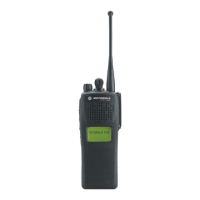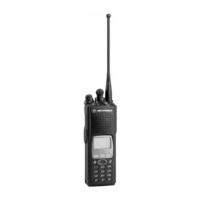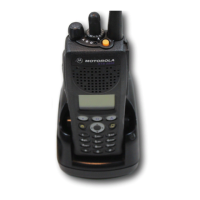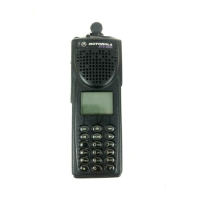Do you have a question about the Motorola BASIC XTS 3000 and is the answer not in the manual?
Inspect the shipping carton for any signs of damage and check contents to ensure all ordered items were shipped.
Overview of radio controls and programmable switches/buttons, referencing their features and programming.
Procedure for powering the radio on and off using the On/Off/Volume Control Knob.
Instructions for selecting a zone and then a specific channel within that zone for operation.
Steps for listening (receiving) and speaking (transmitting) using the radio's controls.
Details on time-out timer functionality and low-battery indication for the radio.
Explanation of the emergency feature, including alarm and call types, and how to enter/exit the state.
Defines various types of individual calls like Telephone, Private-Conversation, and Call-Alert pages.
Feature allowing override of coded squelch (DPL, PL, network ID) on a channel.
Allows selective activation of repeaters for improved coverage, with manual or automatic operation.
Explains how to bypass repeaters for direct radio-to-radio communication (DIRECT operation).
Enables monitoring of activity on different channels by scanning a programmed list.
Details on Tone Private-Line (PL), Digital Private-Line (DPL), network ID, and carrier squelch.
Feature preventing users from talking over other conversations by inhibiting transmission on active channels.
Allows dispatcher to reassign radios to a special channel for communication during special operations.
Feature to notify the dispatcher of a desire for a new dynamic-regrouping assignment.
Dispatcher classification of radios into select-enabled or select-disabled categories.
Per-channel feature transmitting radio's ID automatically with PTT press.
Provides high-level voice security on trunked/conventional channels using digital encryption.
Covers key loading, erasure, and multikey features for managing radio encryption.
Allows selection of power level for transmitting messages, affecting distance and battery life.
Allows overriding a busy tone to obtain voice channels in a SmartZone system.
Feature allowing dispatcher to interrupt radio and place it in a Private Conversation call.
Radio reverts to failsoft operation and channel upon trunking system failure.
Definitions of terms and acronyms used throughout the radio's user manual.
Table detailing various sounds, their names, and the conditions under which they occur.
Guidelines for charging, handling, recycling, and proper disposal of radio batteries.
Provides tips for radio operation, including lighting, squelch, and troubleshooting advice.
Instructions for cleaning and handling the radio to ensure its longevity and proper function.
Warning and guidance regarding the installation of communication equipment in vehicles with air bags.
Information on proper repair, maintenance, Motorola maintenance agreements, and extended service plans.
Inspect the shipping carton for any signs of damage and check contents to ensure all ordered items were shipped.
Overview of radio controls and programmable switches/buttons, referencing their features and programming.
Procedure for powering the radio on and off using the On/Off/Volume Control Knob.
Instructions for selecting a zone and then a specific channel within that zone for operation.
Steps for listening (receiving) and speaking (transmitting) using the radio's controls.
Details on time-out timer functionality and low-battery indication for the radio.
Explanation of the emergency feature, including alarm and call types, and how to enter/exit the state.
Defines various types of individual calls like Telephone, Private-Conversation, and Call-Alert pages.
Feature allowing override of coded squelch (DPL, PL, network ID) on a channel.
Allows selective activation of repeaters for improved coverage, with manual or automatic operation.
Explains how to bypass repeaters for direct radio-to-radio communication (DIRECT operation).
Enables monitoring of activity on different channels by scanning a programmed list.
Details on Tone Private-Line (PL), Digital Private-Line (DPL), network ID, and carrier squelch.
Feature preventing users from talking over other conversations by inhibiting transmission on active channels.
Allows dispatcher to reassign radios to a special channel for communication during special operations.
Feature to notify the dispatcher of a desire for a new dynamic-regrouping assignment.
Dispatcher classification of radios into select-enabled or select-disabled categories.
Per-channel feature transmitting radio's ID automatically with PTT press.
Provides high-level voice security on trunked/conventional channels using digital encryption.
Covers key loading, erasure, and multikey features for managing radio encryption.
Allows selection of power level for transmitting messages, affecting distance and battery life.
Allows overriding a busy tone to obtain voice channels in a SmartZone system.
Feature allowing dispatcher to interrupt radio and place it in a Private Conversation call.
Radio reverts to failsoft operation and channel upon trunking system failure.
Definitions of terms and acronyms used throughout the radio's user manual.
Table detailing various sounds, their names, and the conditions under which they occur.
Guidelines for charging, handling, recycling, and proper disposal of radio batteries.
Provides tips for radio operation, including lighting, squelch, and troubleshooting advice.
Instructions for cleaning and handling the radio to ensure its longevity and proper function.
Warning and guidance regarding the installation of communication equipment in vehicles with air bags.
Information on proper repair, maintenance, Motorola maintenance agreements, and extended service plans.
| Channels | Up to 255 |
|---|---|
| Zones | Up to 16 |
| IP Rating | IP54 |
| Water Resistance | Splash resistant |
| Frequency Range | 136-174 MHz, 403-470 MHz |
| Power Output | VHF: 1-5 W, UHF: 1-4 W |
| Battery Type | NiMH, Li-Ion |
| Battery Life | Up to 10 hours (based on battery type and usage) |
| Signaling | MDC-1200, DTMF |
| Weight | 14.5 oz (with standard battery) |
| Operating Temperature | -30°C to +60°C |











